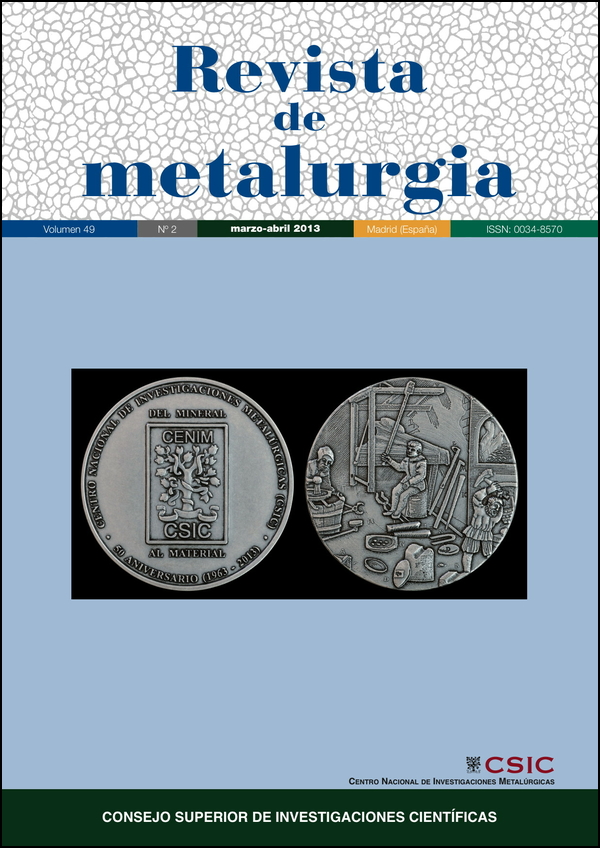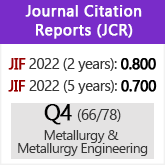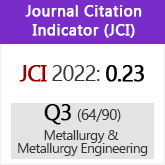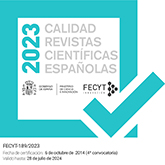Methodology for calculating the thickness free of sigma phase in duplex stainless steels large section parts during hiperquenching
DOI:
https://doi.org/10.3989/revmetalm.1241Keywords:
Sigma-phase, Duplex stainless steel, Surface heat transfer coefficientAbstract
To achieve the mechanical properties and corrosion resistance desired by duplex stainless steels used by the petrochemical and nuclear industry, parts are subjected to a hiperquenching heat treatment from about 1050 °C. This avoids the risk of intermetallic precipitation which drastically reduces the properties of these materials. However with increasing depth to which the deposits are present, the thicknesses for such pipes have been increased, resulting in higher levels of demand on all its manufacturing process, including the heat treatment. To avoid the precipitation of intermetallic phases such as sigma phase it is necessary to know the cooling profile in the center of the workpiece and for this purpose to know the value of the Surface Heat Transfer Coefficient (h) is essential. This coefficient changes during the hiperquenching and its value is determined experimentally as it depends on several process parameters. Studies reveal that its value is stabilized within a few seconds. We can then assume that to know the cooling profile in the center of large sections it is only necessary to know the stabilized value of h. However, all the studies found in the literature are referred to diameters smaller than 100 mm. This paper has developed a methodology to predict the precipitation of intermetallic phases in duplex stainless steel parts with large thicknesses in industrial facilities from the calculation of h. This methodology allows us to calculate the cooling profiles without wasting any workpiece using one or more sensorized patterns with thermocouples and a subsequent simulation with ANSYS.
Downloads
References
[1] Det Norske Veritas, "Design of duplex stainless steel subsea equipment exposed to cathodic protection, Recommended practice Det Norske Veritas DNV-RP-F112", October 2008.
[2] T. Cassagne, Duplex 2007 International Conference & Expo, Grado, Italia, 18-20 June, 2007.
[3] M.P. Rodríguez, J.F. Almagro, J. Botella y P. Valerga, Bol. Soc. Esp. Ceram. 43 (2004) 237-242. http://dx.doi.org/10.3989/cyv.2004.v43.i2.511
[4] G. Fargas, A. Mestra, M. Anglada y A. Mateo, Anales de Mecánica de la Fractura, XXVI Encuentro del Grupo Espa-ol de Fractura, Santander, 2009, pp. 160-165.
[5] G. Fargas, M. Anglada y A. Mateo, VIII Congreso Nacional de Propiedades Mecánicas de Sólidos, Gandía, 2002, pp. 77-86.
[6] J.L. Garin, R.L. Mannheim y M.A. Camus, Rev. Metal. 47 (2011) 296-306. http://dx.doi.org/10.3989/revmetalm.1041
[7] C. Heming, J. Fan y H. Wang. J. Mater. Process. Tech. 63 (1997) 568-572. http://dx.doi.org/10.1016/S0924-0136(96)02685-4
[8] C.E. Bates, G.E. Totten y R.L. Brennan. Quenching of Steel, Heat Treating. Vol 4, ASM Handbook, ASM International, 1991, pp. 67-120.
[9] K. Babu y T.S. Prasanna Kumar, Metall. Mater. Trans. B 41 (2010) 214-224. http://dx.doi.org/10.1007/s11663-009-9319-y
[10] B.A. Anderson y R.P. Singh. Int. J. Refrig. 74 (2006) 383-389.
[11] R. Rabindranath y P. Prakash. J. Food Eng. 110 (2012) 141-157. http://dx.doi.org/10.1016/j.jfoodeng.2011.11.027
[12] J. Zhang y M.A. Delichatsios, Fire Safety J. 44 (2009) 681-690. http://dx.doi.org/10.1016/j.firesaf.2009.01.004
[13] A.A. Ranjbar, M. Ezzati y M. Famouri, J. Mater. Process. Tech. 209 (2009) 5.611–5.617.
[14] H.K. Kim y S.I. Oh, J. Mater.Process. Tech. 112 (2001) 157-165. http://dx.doi.org/10.1016/S0924-0136(00)00877-3
[15] C. Heming, H. Xieqing y W. Honggang, J. Mater. Process. Tech. 89-90 (1999) 339-343. http://dx.doi.org/10.1016/S0924-0136(99)00058-8
[16] L. Huiping, Z. Guoqun, H. Lianfang y M. Yue, Measurement 41 (2008) 676-686. http://dx.doi.org/10.1016/j.measurement.2007.10.003
[17] C. Heming, H. Xieqing y X. Jianbin, J. Mater. Process. Tech. 138 (2003) 399-402. http://dx.doi.org/10.1016/S0924-0136(03)00106-7
[18] R. Mehrotra, A. Vedhanayagam y R. Shivpuri, Transactions of NAMRI, NAMRI/SME XXI, Ontario, Canada, 1993, pp. 73-79.<
[19] A.M. Osman, Ph. D. Thesis, Michigan State University, East Lansing, MI, 1987.
[20] H. Hasan, M. Peet, J. Jalil y H. Bhadeshia, Heat Mass Transfer. 47 (2011) 315-321. http://dx.doi.org/10.1007/s00231-010-0721-4
[21] International Molybdenum Association (IMOA), Practical Guidelines for the Fabrication of Duplex Stainless Steels, ISBN 978-1-907470-00-4, 2009.
Downloads
Published
How to Cite
Issue
Section
License
Copyright (c) 2013 Consejo Superior de Investigaciones Científicas (CSIC)

This work is licensed under a Creative Commons Attribution 4.0 International License.
© CSIC. Manuscripts published in both the printed and online versions of this Journal are the property of Consejo Superior de Investigaciones Científicas, and quoting this source is a requirement for any partial or full reproduction.All contents of this electronic edition, except where otherwise noted, are distributed under a “Creative Commons Attribution 4.0 International” (CC BY 4.0) License. You may read here the basic information and the legal text of the license. The indication of the CC BY 4.0 License must be expressly stated in this way when necessary.
Self-archiving in repositories, personal webpages or similar, of any version other than the published by the Editor, is not allowed.


















